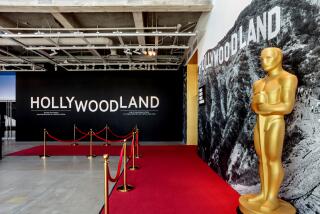Dream factory’s Gotham branch
- Share via
There’s long been a black hole in American cinematic history, a little-known fact that Hollywood swept under the rug during the golden age of the studio system: New York was also a hub of moviemaking from the early 1920s until the end of the 1930s. During those years, studio films, musical shorts and independents were made in the Big Apple, and now the UCLA Film & Television Archive wants to share that secret.
A new book by film historian Richard Koszarski, “Hollywood on the Hudson: Film and Television in New York From Griffith to Sarnoff,” serves as the inspiration for the archive’s retrospective, “Hollywood on the Hudson: Filmmaking in New York From 1920-39,” which opens Friday and continues through Feb. 7 at the Billy Wilder Theater.
Koszarski, who teaches film history at Rutgers University, will introduce Friday’s program of two Paramount musicals from 1929: the groundbreaking “Applause,” directed by Rouben Mamoulian, and the kitschy “Glorifying the American Girl,” supervised by Broadway showman Florenz Ziegfeld and featuring a nearly nude Johnny Weissmuller.
On Saturday, Koszarski will discuss the three silents on the program: the 1920 comedy “His Nibs” and the 1923 short “The Four Orphans,” both directed by Gregory La Cava, and the 1920 pre-noir anthology “While New York Sleeps.”
“Everybody knows that Edison invented the movies, they had nickelodeon studios in New York and had bigger movie studios in Fort Lee, N.J.,” Koszarski says.
Hollywood became a filmmaking mecca by the teens and gradually took the upper hand in the industry by working to brand itself.
“It was consciously developed by both the Hollywood Chamber of Commerce and the Motion Picture Assn.,” Koszarski says. “They plugged the notion that Hollywood was this glamorous spot where dream movies are produced.”
Today’s marketing gurus could take lessons. By creating a mystique, Hollywood cemented itself in the collective consciousness as the home of the movies, regardless of how many pictures were actually filmed there.
“Right from the beginning, Hollywood was not only a physical or geographical place, there was also a mythology,” says Jan-Christopher Horak, head of the UCLA archive. “New York didn’t fit into the concept.”
Paramount managed to sell that story to moviegoers, even though more than 40% of its films made in the mid-1920s were shot at their soundstages in Astoria, N.Y.
“Paramount right after World War I built this big studio in Astoria,” Koszarski says. “When sound comes in, that’s when [studio head] Jesse Lasky said we are going to create a miniature Hollywood in Astoria.”
But, economically, it was a bad idea.
“There was a good reason to move the factory to the West Coast,” Koszarski says. “Films were mass productions of similar objects, and you could keep prices down. You can’t just take a factory and do a miniature version of it and come out with something that makes economic sense.”
The UCLA series features not only studio films but also independent films, race movies and Yiddish productions that came out of the Big Apple.
“The Emperor Jones,” the 1933 adaptation of Eugene O’Neill’s controversial play starring Paul Robeson, screens Sunday evening. The drama about a railway porter who becomes the overpowering dictator of a Caribbean island is considered the first modern independent film.
The New York indies, though, quickly went bust, says Horak, because these productions didn’t have access to the prime theaters, which were operated by the studios. “They would play exploitation houses and the bottom of double bills,” he says.
“They would never make it to the first-run theaters. A lot of them simply fell out of film history. And cultural memory disappears after a certain point.”
--
--
‘Hollywood on the Hudson: Filmmaking in New York 1920-39’
Where: Billy Wilder Theater, 10899 Wilshire Blvd., L.A.
When: Friday through Feb. 7
Price: $7 to $9
Contact: (310) 206-8013
Schedule:
7:30 p.m. Friday: “Applause,” “Glorifying the American Girl”
7:30 p.m. Saturday: “His Nibs,” “While New York Sleeps,” “The Four Orphans”
7 p.m. Sunday: “The Emperor Jones,” “Paradise in Harlem”
7 p.m. Jan. 25: “The Smiling Lieutenant,” “Moonlight and Pretzels”
7:30 p.m. Jan. 30: “Zaza,” “The Green Goddess”
7 p.m. Feb. 1: “One Third of a Nation,” “Cuore D’Emigrante”
7:30 p.m. Feb. 7: “Crime Without Passion,” “Back Door to Heaven”
More to Read
Only good movies
Get the Indie Focus newsletter, Mark Olsen's weekly guide to the world of cinema.
You may occasionally receive promotional content from the Los Angeles Times.











